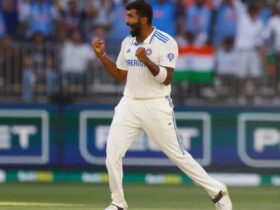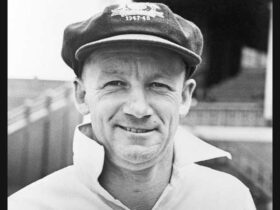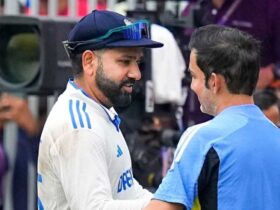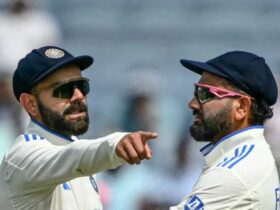The lack of depth in India’s attack showed as the day went on as Head and Smith added 241 in 302
Australia 405 for 7 (Head 152, Smith 101, Carey 45*, Bumrah 5-72) vs India
Centuries from Travis Head and Steven Smith, those two great India tormentors, put Australia in control of the third Border-Gavaskar Test at the Gabba, on a fast-moving second day that produced 377 runs and seven wickets. Five of those wickets fell to the exceptional Jasprit Bumrah, who kept India in the contest almost singlehandedly while swelling his overall Test tally in Australia to 49; Kapil Dev (51) is now the only Indian bowler ahead of him.
Almost singlehandedly, because Bumrah wasn’t the only India quick to trouble Australia here. Akash Deep kept landing the ball in testing areas and induced almost as many false shots (45) as Bumrah did (46), but ended the day wicketless. Mohammed Siraj put in a solid shift too, and for most of the first session India applied pressure from both ends and had Australia on a tight leash.
The lack of depth in India’s attack began to tell as the day wore on, though, and Australia pulled away as Head and Smith added a rollicking 241 for the fourth wicket in 302 balls. The second new ball gave India some respite, with Bumrah dismissing Smith, Mitchell Marsh and Head in the space of 12 balls, but Australia were already in a superb position by then.
At stumps, they were 405 for 7, and in a position to dictate the shape of the rest of this Test match, although time (all but 13.2 overs of day one were washed out) and the weather may yet complicate their push for a win.
India yet again had no answer to the thorny problem Head poses: how do you bowl to a batter whose stock response to the top-of-off line and length is a fast-hands square cut? They tried various options, but nothing really worked, and their attempts at going short proved particularly futile: their bouncers weren’t hostile or accurate enough to cramp Head consistently for room, and the pace and bounce of this Gabba pitch too true to cause indecision.
Instead of tucking him up and making him look awkward, India typically allowed Head to lean back and ramp the ball away over the slips.
The bigger issue for India was their lack of sustained wicket threat beyond their three main quicks. Nitish Kumar Reddy and Ravindra Jadeja, their fourth and fifth bowlers, gave away 141 runs over a combined 29 overs, while picking up just the one wicket. That wicket was a vital one, leaving Australia 75 for 3, but it was revealing that it was the result of a loose drive from Marnus Labuschagne rather than a genuine wicket-taking delivery.
The problem of the fourth and fifth bowler was particularly pronounced after the tea break, when India resumed with a 70-over-old ball. It left them with a conundrum: they could either start the session with their best bowlers, or preserve them for the second new ball which was 10 overs away. They started with Reddy and Jadeja, and went on to concede 63 runs in the first 10 overs of the session.
Steven Smith found his hands…and more•Chris Hyde / Getty Images
Smith, in particular, blossomed during this period, and surged in confidence after having had to struggle through his first half-century. He came into this innings with the big, back-and-across trigger movement that he had shelved following his first-ball duck in the first innings in Perth, and it took him a while to find any fluency. He was beaten numerous times in the corridor, particularly by Akash Deep, and had played 30 false shots by the time he’d reached his half-century.
It was a measure of how much he was struggling, because each of the other 11 innings in Smith’s Test career with 30 or more false shots were centuries. But perhaps it was a portent too, and his wagon wheel blossomed after he brought up his fifty, with India no longer able to restrict him to just the leg-side scoring shots. Smith’s first fifty took him 128 balls, and his second just 57. And he only played eight false shots after reaching the half-century mark.
The last of them was an expansive drive off Bumrah that he edged to slip after India had taken the second new ball. In his next over, Bumrah struck two more times to send back Marsh and Head, and like the wicket of Smith, these two also came from balls that landed in the perfect length to bring the batters forward without allowing them to drive safely, in the perfect channel to force them into playing, and with just enough seam movement to find the outside edge.
It’s the most fundamental thing about bowling in Test cricket, but finding that right area for a particular pitch can be a long and arduous process for even the best of bowlers. Bumrah had himself taken his time finding it on day one.
It was almost inevitable, however, that he would find it as soon as day two dawned. His six-over spell in the morning was all but unplayable, with 14 of his 30 balls inducing false shots, and two of them sending back Australia’s openers.
He drew Usman Khawaja onto the front foot and got him feeling for the ball three times in a row, beating his bat with the last two balls of his first over of the day and finding his edge of the first ball of his second.
An over later, Nathan McSweeney had fallen to Bumrah for the fourth time in his five-innings Test career, squaring up and edging an away-seamer to second slip, where Virat Kohli took the first of his three catches on the day. Bumrah had bowled five overs on day one, but McSweeney had only faced three balls from him. Now he was out, having been exposed to his nemesis for three balls in a row, leaving their overall Test-match head-to-head reading 52 balls, 12 runs, four dismissals.
A tense period followed, with Labuschagne and Smith putting on 37 off 89 balls, with their doggedness at leaving the ball on length standing out as the main feature of their partnership. It may not have made the pulse race, but it served an important function for Australia, allowing Head to walk in when the ball was 33.2 overs old and doing significantly less than at the start of the day, and when the three main quicks had already bowled 29











Leave a Reply